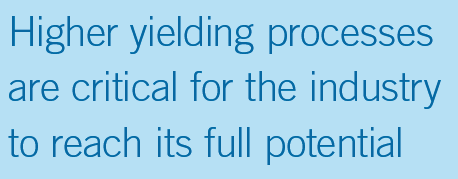Deeper Dive: Gene Therapy Manufacturing
Pharmaceutical Executive
Hari Pujar, chief technology officer of Spark Therapeutics, discusses the unique manufacturing and scale-up challenges involved with cell and gene therapy production.
In the following Q&A, Hari Pujar, PhD, chief technology officer, Spark Therapeutics, discusses the unique manufacturing and scale-up challenges involved with cell and gene therapy production. Pujar leads Spark’s technology development, technical operations, and quality assurance organizations. Prior to Spark, Pujar was most recently vice president, technical development and manufacturing, at Moderna Therapeutics.
For those who may not be familiar with the gene therapy manufacturing process, could you please provide a brief explanation of the process?
With the first gene therapy for a genetic disease approved in 2017, and FDA expecting more than 200 investigational new drug (IND) applications each year starting in 2020, we are in the midst of rapid progress.
Hari Pujar

Yet one of the biggest challenges that we face is keeping pace with the advancement and, more specifically, innovating our manufacturing and commercialization processes to meet the growing demand
Up until now, gene therapy companies have been focused on discovering and manufacturing therapies for ultra-rare diseases that affect very small patient populations. But today, as the science is evolving, developers are focused on therapies to treat larger patient populations with more complex diseases involving multiple genetic mutations. This will require advancements in manufacturing that enable companies to create new modes of administration, at a greater scale, and as efficiently as possible.
One of the most unique aspects of gene therapy manufacturing is the production of the viral vectors that are used to transport the new genes into a patient’s cells. To produce these vectors, the two commonly used methods are roller bottle cell culture (with adherent cell lines) and suspension cell culture (with suspension-adapted cell lines). Since the first days of biotechnology, we have manufactured medicines with roller bottles, or the adherent approach. In the adherent approach, cells need the surface area of a roller bottle to attach to. While effective, this can be a labor-intensive process and inefficient in producing viral vectors at a scale needed for large patient populations.
A newer approach that is more scalable and efficient is the suspension process. Within this process, bioreactors, or vessels, grow the cells in liquid-all without the additional surface area required in scaling up the adherent approach. Once cells grow to the right density, another unique part of the gene therapy manufacturing process can take place, which is called transient transfection. During this process, cells are treated with agents to make their membranes porous enough to allow for the introduction of plasmid DNA, which can then be delivered into cells. Plasmid DNA has to be manufactured or sourced independently. Further advances to this process include the use of stable transfection (in contrast to transient transfection).
While both of these upstream processes-whether by adherent or suspension cell culture-produce the virus, the virus needs to be purified to an appropriate quality by way of downstream purification. It is important for this process to purify the virus from both cellular impurities and process additives, while keeping the biological activity of the virus intact. Unit operations are analogous to those used for protein biologics such as chromatography and filtration. Finally, the virus needs to be formulated in an appropriate buffer that maintains the biological activity while enabling long-term storage in appropriate containers.
There has been much discussion about challenges associated with manufacturing gene therapy for scalable production. What do you see as some of the greatest challenges today?
The three biggest challenges and opportunities I see today are:
1.Making our processes more efficient to scale up quickly and meet growing demand, while not compromising quality. This includes the previously described shift to the suspension process to produce a larger yield of viral vectors. This shift to a more efficient process can be done in smaller facilities, which are more easily instituted and scaled-up by gene therapy companies. Higher yielding processes are critical for the industry to reach its full potential, as large quantities of virus will be needed as more complex diseases

are interrogated.
2.Building talented manufacturing teams with the right experience. A common dilemma in gene therapy manufacturing is whether to outsource capabilities. Decisions like these are not made lightly and are often unique to the therapy and company. At Spark, we’ve chosen to grow our team internally, sourcing talent from various backgrounds and industries. It is essential to have a team that knows how to design and run a manufacturing process and facility for product commercialization. Unlike small molecules, the manufacturing process for a gene therapy can be an important determinant for the pharmacology of the product, and thus process and biology are interlinked.
3. Standardizing the gene therapy manufacturing process. We can develop therapies for a wide range of different, complex diseases without recreating the wheel each time. This will require a platform process that can be applied from one product to the next. The process has many advantages, including continual technology improvement via repetition and iteration, speed of implementation, and efficient use of facility and staff. Platform technology not only applies to the manufacturing process but also all associated technology solutions.
What are the unique ways the gene therapy industry is working to evolve the manufacturing processes for improved efficiencies and speed of delivery?
By leveraging the many advances made by the monoclonal antibody, or more broadly, the recombinant protein industry. These include the use of suspension cell culture, single-use technologies, and chromatography-based purification. In addition, other approaches such as the use of stable cell lines and protein engineering are also being used to improve manufacturing and product profiles. The use of DNA plasmids and helper viruses to manufacture viral vectors are unique aspects of gene therapy, and advances in these starting materials will also yield enhanced efficiencies.
How does the manufacturing process engage the R&D team? And how early are you engaging with other teams to ensure the quality of the product?
Every gene therapy is currently different, so to create the most efficient and effective manufacturing process, the R&D team must engage the manufacturing team very early. The two must communicate about a variety of issues, including the quality target product profile, the dose levels to be interrogated, and the anticipated patient demand. Since the clinical development window is so short, we must ensure there are enough supplies of clinical material available, and that the process can be rapidly scaled up, especially as we prepare for pivots into phases later in the product lifecycle.
With appropriate collaboration, the process development and manufacturing teams can work with the clinical team to design a better product, and they can collaborate to evaluate the investigational therapy for safety and efficacy as expeditiously as possible.
If you could build your ideal gene therapy manufacturing facility, what would it look like? And how long do you think it’ll take to get there?
To support the introduction of the first gene therapy for a genetic disease, approved by FDA in 2017, Spark built, from scratch, the only in-house FDA- and European Medicines Agency (EMA)-licensed gene therapy manufacturing facility in the US. We are proud of what we accomplished in a short period of time and the company learned a lot through this process. Some things on my “wish list” for future facilities include:
1. A flexible, multi-product gene therapy manufacturing facility. This allows us to seamlessly support various products-for small and large patient populations-from early-stage clinical manufacturing through commercial manufacturing. This would not only cut down on costs, but also speed up delivery by being able to manufacture multiple therapies simultaneously.
2.Platform processes and assays with state-of-the-art unit operations. This can be used across all clinical development programs. Traditionally, each gene therapy product is created with a different manufacturing system, especially as varying types of viral vectors are used to transport the correct genes. Settling on a platform approach can help proactively plan the supply needs, materials, and manufacturing capacity required for their clinical and commercial purposes, ultimately saving time, money, and resources.
3.Use of robotics, automation, and digital technology. Use of these technologies is an absolute imperative to enhance product quality, reduce cost with optimum cycle time, while enabling continuous improvement via data science.
- Staff Report

Cell and Gene Therapy Check-in 2024
January 18th 2024Fran Gregory, VP of Emerging Therapies, Cardinal Health discusses her career, how both CAR-T therapies and personalization have been gaining momentum and what kind of progress we expect to see from them, some of the biggest hurdles facing their section of the industry, the importance of patient advocacy and so much more.
Applying Porter’s Five Forces to Portfolio Management in Pharmaceutical R&D: A Strategic Roadmap
March 17th 2025The increasing costs and complexity of R&D in the pharmaceutical industry have necessitated the adoption of strategic portfolio management to optimize resource allocation and enhance competitive advantage.